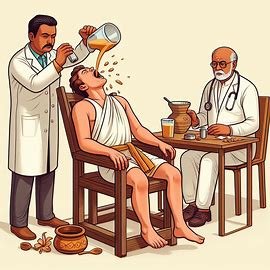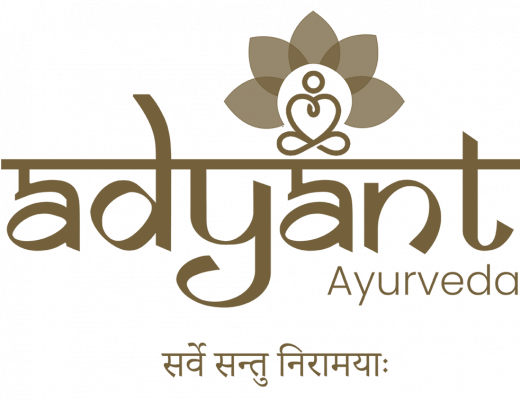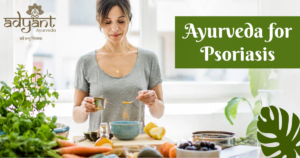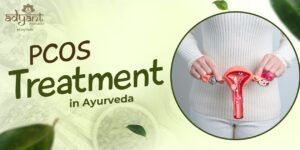Panchakarma Treatment for Psoriasis: Psoriasis is an autoimmune condition that affects the skin. In psoriasis, it is found to rapidly overgrow with skin cells leading to the formation of thick, scaly patches on the skin. This happens due to an overactive immune system.
Psoriasis Symptoms Include:
- Red patches of skin covered with thick, silvery scales
- Dry, cracked skin that may bleed
- Itching, burning, or soreness
- Thickened, pitted, or ridged nails
- Swollen and stiff joints
The severity of psoriasis can vary greatly, ranging from small, faint dry skin patches to severe cases where a person’s entire body may be covered with thick, red, scaly skin plaques.
For Free Consultation With Top Ayurvedic Doctors, Download Our App “AyurCare“
Types of Psoriasis
There are various types of psoriasis, each exhibiting unique features:
- Plaque Psoriasis: This is the most prevalent form of psoriasis, characterized by red patches that are covered with silvery-white scales.
- Guttate Psoriasis: Guttate psoriasis is identified by small, red, teardrop-shaped spots, which are often prompted by bacterial infections.
- Inverse Psoriasis: This type presents smooth, red patches found in skin folds, which can worsen due to friction and sweating.
- Pustular Psoriasis: In pustular psoriasis, one can observe white, pus-filled blisters surrounded by red, inflamed skin.
- Erythrodermic Psoriasis: This is a rare and serious form that can cover extensive areas of the body with a bright red rash that sheds scales in large sheets.
- Nail Psoriasis: This variant impacts the nails, leading to pitting, thickening, or separation from the nail bed.
- Scalp Psoriasis: This type affects the scalp, resulting in red, scaly patches, and it may cause hair loss if not treated appropriately.
Read Also: Ayurvedic Treatment for Psoriasis
Ayurvedic Perspective on Psoriasis
In Ayurveda, skin disorders are classified under the broad category of Kushta Roga. Psoriasis, specifically, can be related to three sub-types of Kushta:
- Kitibha: Characterized by blackish-brown, rough, and scaly lesions.
- Sidhma: Presents as fine, whitish scales, often compared to the flower of the alabaster plant.
- Ekakushta: Manifests as widespread, fish-scale-like lesions.
According to Ayurvedic principles, psoriasis results from an imbalance in the Vata and Kapha doshas, with varying degrees of Pitta involvement. The condition is believed to arise from:
- Irregular food habits
- Consumption of incompatible food combinations (e.g., fish and milk)
- Excessive intake of certain foods (curds, seafood, black gram, sour and salty foods)
- Stress
In the Ayurvedic understanding, these factors lead to vitiation of the doshas, which then affect the twak (skin) and Rakta (blood), resulting in skin disorders.
Understanding Psoriasis from an Ayurvedic Perspective
Imbalance of Doshas in Psoriasis
In the practice of Ayurveda, psoriasis is seen as a result of imbalanced doshas, mainly Vata and Kapha, with some involvement of Pitta. The specific imbalances of these doshas lead to the typical symptoms associated with psoriasis:
Imbalance of Vata:
- Causes dryness and scaling on the skin
- Affects the fast turnover of skin cells
- May lead to itching and discomfort
Imbalance of Kapha:
- Results in thickening of the skin
- Contributes to the development of plaques
- It can create a sensation of heaviness or congestion in affected regions
Involvement of Pitta: Although not the primary factor, it can contribute to inflammation and redness May intensify itching and burning sensations
The roles of Vata and Kapha in psoriasis are particularly important to note. This combination can result in distinctive dry, scaly patches (influenced by Vata) that are also thick and persistent (influenced by Kapha).
Read Also: Ayurveda Doshas
Causes of Having Psoriasis According to Ayurveda
Ayurveda identifies several factors that can contribute to the development and exacerbation of psoriasis:
- Irregular Food Habits:
- Eating at irregular times
- Consuming food that is not fresh or properly prepared
- Overeating or undereating
- Incompatible Food Combinations (Viruddha Ahara):
- Consuming incompatible food combinations, such as fish and milk together
- Eating excessive amounts of certain foods, including:
- Curds (yogurt)
- Seafood
- Black gram
- Sour and salty foods
- Stress:
- Emotional stress is considered a significant trigger for psoriasis
- Chronic stress can disrupt the balance of doshas and weaken the immune system
- Lifestyle Factors:
- Lack of proper sleep
- Sedentary lifestyle
- Exposure to environmental toxins
- Seasonal Changes:
- Aggravation of symptoms during certain seasons, particularly winter
- Accumulation of Toxins (Ama):
- Poor digestion leads to the formation of toxins
- Accumulation of these toxins in the body, particularly affecting the skin and blood
According to Ayurvedic principles, these factors lead to the vitiation of doshas, particularly Vata and Kapha. The vitiated doshas then affect the twak (skin) and Rakta (blood), resulting in the manifestation of psoriasis symptoms.
Know Also: Best Ayurvedic Clinic and Hospital for Psoriasis in Bangalore
Development of Psoriasis in Ayurveda
The development of psoriasis in Ayurveda is understood as follows:
- Causative factors lead to dosha imbalance
- Imbalanced doshas affect the dhatus (tissues), particularly rasa (plasma) and rakta (blood)
- This results in the accumulation of toxins (ama) in the body
- The skin, being a site of toxin elimination, becomes affected
- The combination of dosha imbalance and toxin accumulation manifests as psoriasis symptoms
Understanding this Ayurvedic perspective on psoriasis is crucial for developing an effective treatment approach using Panchakarma and other Ayurvedic therapies.
Introduction to Panchakarma for Psoriasis
Definition and Purpose of Panchakarma
Panchakarma is a cornerstone of Ayurvedic medicine, representing a comprehensive system of detoxification and rejuvenation therapies. The term “Panchakarma” literally translates to “five actions” or “five treatments,” referring to the five principal therapeutic procedures used in this approach.
In the context of psoriasis treatment, Panchakarma serves several crucial purposes:
- Detoxification: Panchakarma aims to eliminate accumulated toxins (ama) from the body, which are believed to contribute to the development and exacerbation of psoriasis.
- Balancing Doshas: The therapies work to restore balance to the Vata and Kapha doshas, which are primarily implicated in psoriasis according to Ayurvedic understanding.
- Improving Circulation: Many Panchakarma treatments enhance blood circulation, promoting better nutrient delivery to the skin and facilitating the removal of waste products.
- Strengthening the Immune System: By cleansing the body and promoting overall health, Panchakarma helps to modulate the immune system, which is crucial in managing autoimmune conditions like psoriasis.
- Stress Reduction: Several Panchakarma therapies have a calming effect on the mind and body, helping to alleviate stress, which is a known trigger for psoriasis flare-ups.
Read Also: What is Panchakarma
Holistic Approach to Psoriasis Treatment in Ayurveda
Panchakarma embodies the holistic principles of Ayurveda in its approach to treating psoriasis:
- Whole-Body Focus: Rather than targeting only the skin symptoms, Panchakarma addresses the entire body-mind system. This approach recognizes that skin health is a reflection of overall bodily health.
- Personalized Treatment: Panchakarma therapies are tailored to the individual’s unique constitution (Prakriti) and the specific nature of their dosha imbalance. This personalization ensures that the treatment is optimally effective for each patient.
- Multi-faceted Approach: Panchakarma combines various therapeutic techniques, including massage, herbal treatments, and cleansing procedures, to address different aspects of psoriasis simultaneously.
- Root Cause Treatment: By focusing on eliminating toxins and balancing doshas, Panchakarma aims to address the root causes of psoriasis according to Ayurvedic principles, rather than merely managing symptoms.
- Integration of Diet and Lifestyle: Panchakarma treatment for psoriasis is typically accompanied by dietary and lifestyle recommendations, creating a comprehensive healing plan.
- Long-term Health Promotion: Beyond immediate symptom relief, Panchakarma aims to promote long-term skin health and overall well-being, potentially reducing the frequency and severity of psoriasis flare-ups.
The holistic nature of Panchakarma makes it a powerful complementary approach to conventional psoriasis treatments. By addressing multiple aspects of health simultaneously, Panchakarma offers the potential for more comprehensive and sustainable improvements in psoriasis symptoms.
Role of Panchakarma in Psoriasis Management
In the management of psoriasis, Panchakarma plays several key roles:
- Shodhana (Purification): This includes therapies like Vamana (therapeutic emesis) and Virechana (purgation) that help remove excess doshas and toxins from the body.
- Shamana (Pacification): Certain Panchakarma therapies help to pacify aggravated doshas, bringing relief from psoriasis symptoms.
- Rasayana (Rejuvenation): Following the purification and pacification treatments, rejuvenating therapies are employed to strengthen the tissues and improve overall health.
By combining these approaches, Panchakarma offers a comprehensive strategy for managing psoriasis that aligns with Ayurvedic principles of health and healing.
Panchakarma Procedures for Psoriasis
Panchakarma offers a range of therapeutic procedures that can be beneficial in the treatment of psoriasis. Each procedure addresses different aspects of the condition, working together to promote overall skin health and alleviate symptoms.
Abhyangam
Abhyanga is a form of Ayurvedic massage that involves the application of warm herbal oils to the entire body using specific strokes and techniques.
Benefits for Psoriasis
- Hydration: The oils used in Abhyanga deeply nourish and hydrate the skin, helping to alleviate dryness and scaling associated with psoriasis.
- Improved Circulation: The massage techniques enhance blood circulation, promoting better nutrient delivery to the skin and facilitating the removal of toxins.
- Stress Reduction: Abhyanga has a calming effect on the nervous system, helping to reduce stress, which is a known trigger for psoriasis flare-ups.
- Dosha Balancing: Different oils can be used to balance specific doshas, addressing the underlying imbalances contributing to psoriasis.
Snehana
Snehana, also known as oleation therapy, involves the internal and external application of medicated oils or ghee to lubricate and soften the body tissues.
Role in Reducing Inflammation and Improving Skin Health
- Toxin Mobilization: The oils help to loosen and mobilize toxins stored in the tissues, preparing them for elimination.
- Anti-Inflammatory Effects: Many of the herbs used in the medicated oils have anti-inflammatory properties, helping to reduce skin inflammation.
- Digestive Cleansing: Internal oleation helps to cleanse the digestive tract, which is crucial for overall skin health according to Ayurveda.
Virechana Treatment for Psoriasis
Virechana Treatment is a controlled purgation therapy that uses herbal laxatives to eliminate excess Pitta and toxins from the body.
Benefits for Liver Function and Systemic Inflammation
- Liver Detoxification: Virechana is particularly effective in cleansing the liver, which plays a crucial role in detoxification and skin health.
- Reduction of Systemic Inflammation: By eliminating excess Pitta and toxins, Virechana helps to reduce overall body inflammation, which can contribute to psoriasis symptoms.
- Balancing of Doshas: This therapy is especially useful in pacifying aggravated Pitta, which can contribute to the inflammatory aspect of psoriasis.
Swedana Treatment
Swedana is a therapeutic sweating treatment that uses herbal steam to induce perspiration.
Effects on Circulation and Inflammation Reduction
- Enhanced Circulation: The heat and steam improve blood circulation throughout the body, including to the skin.
- Opening of Skin Pores: Swedana helps to open the skin pores, facilitating the elimination of toxins through sweat.
- Reduction of Inflammation: The heat can help to reduce inflammation and soothe irritated skin.
- Preparation for Other Therapies: Swedana is often used to prepare the body for other Panchakarma treatments by softening the tissues and mobilizing toxins.
Panchakarma Vamana Treatment for Psoriasis
Vamana is a controlled therapeutic emesis procedure designed to eliminate excess Kapha from the body.
Benefits of Removing Excess Kapha and Impurities:
- Kapha Reduction: By removing excess Kapha, Vamana can help address the thickening and congestion aspects of psoriasis plaques.
- Upper Body Detoxification: This therapy is particularly effective for eliminating toxins from the upper parts of the body, including the skin.
- Immune System Modulation: Vamana can help balance the immune system, which is crucial in managing autoimmune conditions like psoriasis.

Additional Panchakarma Therapies for Psoriasis Treatment
Takradhara for Psoriasis
Takradhara is a specialized treatment where medicated buttermilk is poured over the forehead in a continuous stream.
- Stress Reduction: This therapy is particularly effective in reducing stress and calming the mind, which can help manage psoriasis flare-ups.
- Cooling Effect: The buttermilk has a cooling effect, which can be beneficial for inflamed skin.
Raktamokshana (if applicable)
Raktamokshana is a controlled bloodletting therapy used in certain cases to purify the blood.
- Blood Purification: This therapy can help remove toxins from the bloodstream, which is believed to contribute to skin health.
- Reduction of Skin Inflammation: By purifying the blood, Raktamokshana may help reduce inflammation in the skin.
Benefits of Panchakarma Treatment for Psoriasis
Panchakarma offers a holistic approach to treating psoriasis, addressing not just the symptoms but also the root causes of the condition according to Ayurvedic principles. Here are the key benefits of Panchakarma for individuals suffering from psoriasis:
Detoxification and Toxin Removal
Panchakarma’s primary focus is on eliminating toxins (ama) from the body, which is crucial in managing psoriasis.
- Ama Elimination: The various Panchakarma procedures work together to remove accumulated toxins from the body’s tissues and channels.
- Cellular-Level Cleansing: Therapies like Abhyanga and Swedana help to dislodge toxins at the cellular level, preparing them for elimination.
- Digestive System Purification: Procedures like Virechana and Vamana cleanse the digestive system, which is considered a primary source of toxin accumulation in Ayurveda.
- Skin Detoxification: By promoting sweating and improving circulation, therapies like Swedana help the skin, the body’s largest organ of elimination, to expel toxins more effectively.
Impact on Psoriasis: Reducing the toxic load in the body can help alleviate the severity of psoriasis symptoms and potentially decrease the frequency of flare-ups.
Balancing of Doshas
Panchakarma aims to restore balance to the body’s doshas, particularly Vata and Kapha, which are often implicated in psoriasis.
- Vata Pacification: Therapies like Abhyanga with warm oils help to balance Vata, potentially reducing dryness and scaling associated with psoriasis.
- Kapha Reduction: Procedures like Vamana help to remove excess Kapha, which can contribute to the thickening of the skin in psoriatic plaques.
- Pitta Modulation: While not primary in psoriasis, balancing Pitta through treatments like Virechana can help manage inflammation associated with the condition.
Impact on Psoriasis: By addressing the underlying dosha imbalances, Panchakarma can help manage the root causes of psoriasis according to Ayurvedic principles, potentially leading to long-term improvement.
Strengthening the Immune System
Psoriasis is an autoimmune condition, making immune system modulation a crucial aspect of its management.
- Immune Modulation: The detoxification and balancing effects of Panchakarma can help regulate immune system function.
- Improved Circulation: Therapies that enhance blood circulation, like Abhyanga and Swedana, can boost the delivery of immune cells throughout the body.
- Digestive Health: By cleansing and strengthening the digestive system, Panchakarma supports gut health, which is closely linked to immune function.
- Stress Reduction: Many Panchakarma therapies have a calming effect, reducing stress which can positively impact immune function.
Impact on Psoriasis: A well-modulated immune system may help reduce the autoimmune response that leads to the rapid skin cell turnover characteristic of psoriasis.
Stress Management
Stress is a known trigger for psoriasis flare-ups, making stress management an essential component of psoriasis treatment.
- Relaxation Response: Therapies like Abhyanga and Shirodhara induce a deep state of relaxation, helping to reduce stress levels.
- Nervous System Regulation: Many Panchakarma treatments have a balancing effect on the nervous system, promoting a state of calm.
- Mind-Body Connection: The holistic approach of Panchakarma acknowledges and addresses the connection between mental stress and physical symptoms.
- Improved Sleep: Many patients report improved sleep quality following Panchakarma, which can have a positive impact on stress levels and overall health.
Impact on Psoriasis: By reducing stress, Panchakarma may help prevent stress-induced psoriasis flare-ups and improve overall quality of life for individuals with psoriasis.
Additional Benefits
- Improved Skin Hydration: Oil-based therapies like Abhyanga can significantly improve skin hydration, addressing the dryness often associated with psoriasis.
- Enhanced Nutrient Delivery: Improved circulation resulting from various Panchakarma therapies can enhance the delivery of nutrients to the skin.
- Promotion of Healing: The combination of detoxification, improved circulation, and stress reduction can create an internal environment more conducive to skin healing.
- Holistic Wellness: Beyond skin health, Panchakarma promotes overall well-being, which can have indirect positive effects on psoriasis management.
Post-Panchakarma Care for Psoriasis: A Holistic Approach
After completing Panchakarma for managing psoriasis, it is vital to follow a specific post-care regimen to maintain the results and prevent flare-ups. Psoriasis, being a chronic condition, requires long-term management through diet, lifestyle modifications, and Shamana Chikitsa (pacifying therapies).
Dietary Guidelines Used in Panchakarma Treatment for Psoriasis
The right diet plays a significant role in controlling psoriasis symptoms. Ayurveda emphasizes consuming foods that balance the Pitta and Kapha Doshas, which are often responsible for skin conditions like psoriasis.
Foods to Avoid:
- Spicy and acidic foods: Foods that aggravate Pitta Dosha, such as chili, garlic, onion, and fermented foods, can trigger inflammation.
- Dairy products: Particularly curd and cheese, increase Kapha and lead to the accumulation of toxins (Ama).
- Fried and oily foods: These can block channels in the body and aggravate Kapha, leading to flare-ups.
- Red meat: Difficult to digest and increases Pitta, worsening skin conditions.
- Refined sugars and processed foods: These contribute to inflammation and Ama formation.
- Alcohol and caffeine: Both substances aggravate Pitta and should be avoided for psoriasis management.
Recommended Foods:
- Whole grains: Quinoa, barley, and millet are excellent alternatives to refined grains as they are easier to digest and help balance Pitta.
- Bitter vegetables: Bitter gourd, neem, and leafy greens like spinach and kale help pacify Pitta and reduce toxins.
- Fresh fruits: Apples, pomegranates, and pears help maintain digestive health and cool down the body.
- Ghee: Small amounts of clarified butter aid digestion, lubricate tissues, and pacify aggravated Pitta.
- Cumin, coriander, and turmeric: These spices help reduce inflammation, balance Pitta, and promote skin healing.
- Warm water: Drinking warm water throughout the day helps flush out toxins and maintains healthy digestion.
Lifestyle Modifications for Psoriasis
In addition to diet, making appropriate lifestyle changes is crucial for maintaining the effects of Panchakarma and managing psoriasis in the long term.
-
Stress Management:
-
- Yoga and meditation are highly recommended to calm the mind and reduce stress, which is a major trigger for psoriasis flare-ups.
- Pranayama (breathing exercises) like Anulom-Vilom and Sheetali can help pacify Pitta and reduce mental stress.
-
Daily Routine (Dinacharya):
-
- Follow a consistent daily routine that includes waking up early, maintaining proper hygiene, and getting adequate rest.
- Engage in light exercises like walking or swimming, avoiding overly strenuous activities that may overheat the body.
-
Skin Care:
-
- Regular application of medicated oils like Kumkumadi Taila or Neem oil helps to keep the skin moisturized and reduce itching.
- Avoid harsh soaps and use mild, natural cleansers to maintain the skin’s moisture.
-
Sun Exposure:
-
- Moderate exposure to the sun is beneficial, as it provides natural Vitamin D, which helps improve skin conditions.
- Avoid excessive exposure during peak hours, which can worsen inflammation due to Pitta aggravation.
-
Adequate Sleep:
-
- Ensure that you get 7-8 hours of restful sleep each night, as lack of sleep can weaken the immune system and trigger psoriasis flare-ups.
Shamana Chikitsa (Pacifying Therapies)
After completing Panchakarma, it is important to follow Shamana Chikitsa to maintain the results and manage psoriasis symptoms continuously.
-
Herbal Formulations:
-
- Arogyavardhini Vati: Known to pacify Pitta and Kapha, and effective for treating skin disorders.
- Kaishore Guggulu: A blood-purifying formula that helps remove toxins and reduces inflammation.
- Neem (Nimba): Neem capsules or decoctions can help reduce itching, redness, and inflammation in psoriasis.
-
Medicated Oils:
-
- Mahamarichyadi Taila or Kumkumadi Taila can be used for external application to soothe irritated skin and promote healing.
- Rasayanas (Rejuvenative Therapies):
-
- Chyawanprash and Guduchi are effective for boosting immunity and reducing recurrences of psoriasis.
Panchakarma Treatment for Psoriasis: Closing Thought
Panchakarma plays a pivotal role in the natural and alternative treatment of psoriasis by focusing on the root causes of the condition—imbalances in the Doshas (primarily Pitta and Kapha) and the accumulation of toxins (Ama) in the body. Through a combination of detoxification therapies like Vamana (therapeutic vomiting), Virechana (purgation), and Basti (medicated enema), Panchakarma works to cleanse the body and restore balance.
One of the most significant advantages of Panchakarma is its holistic approach. It addresses the physical symptoms of psoriasis and the mental and emotional aspects, promoting overall well-being. Post-Panchakarma care, including dietary modifications, lifestyle changes, and Shamana Chikitsa (pacifying therapies), further helps maintain the long-term benefits and prevent recurrences. Adyant Ayurveda is a chain of Best Panchakarma treatment centers in Bangalore with expertization of 24 years in Ayurveda.
For Panchakarma treatment for Psoriasis visit the Adyant Ayurveda clinic near your home. We have 4 Clinics in Bangalore
- Adyant Ayurveda Jayanagar
- Adyant Ayurveda Indiranagar
- Adyant Ayurveda Rajrajeshwari Nagar
- Adyant Ayurveda Kalyan Nagar






